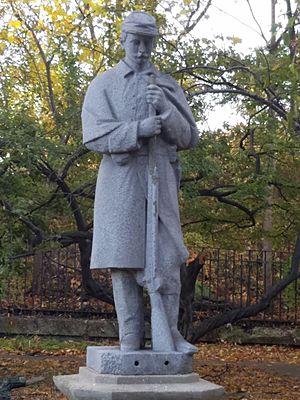Valentine–Varian House facts for kids
|
Valentine–Varian House
|
|

Valentine–Varian House, September 2008
|
|
| Location | 3266 Bainbridge Avenue, Norwood, Bronx, New York 10467 |
|---|---|
| Built | 1758 |
| NRHP reference No. | 78001841 |
Quick facts for kids Significant dates |
|
| Added to NRHP | March 21, 1978 |
The Valentine–Varian House is a very old and important house in the Norwood area of the Bronx, New York City. It was built in 1758 by a man named Isaac Valentine. This makes it the second oldest house in the Bronx and the oldest farmhouse still standing.
The house was owned by the Varian family for many years. A famous member of this family was Isaac Varian, who became the 63rd Mayor of New York City. The house was sold in 1905. Today, it is part of the Historic House Trust. It is home to the Museum of Bronx History and the offices of the Bronx County Historical Society. The house is made of stone and has two floors. It was moved to its current spot in 1965 and fixed up between 1965 and 1968.
Contents
History of the Valentine–Varian House
This house is the second oldest in the Bronx. Isaac Valentine, a successful blacksmith and farmer from Yonkers, built it in 1758. He used materials found nearby, like pine trees for the floors and stone for the outside walls.
The House During the Revolutionary War
During the American Revolutionary War, the Valentine–Varian House was a busy place. Soldiers from Germany (called Hessians), British troops, and American soldiers all stayed there at different times. Even though many battles happened nearby, the house survived the war.
The British took control of the house in 1776. At that time, George Washington, the leader of the American army, was staying nearby at the Van Cortlandt House. The Valentine–Varian House became a place where British and American soldiers often fought. Isaac Valentine had many unexpected visitors because soldiers would stay in his house without his permission.
However, George Washington used the house as a smart location to help defeat the British. The house is on Bainbridge Avenue, which was the highest point on the east side of the Bronx. From this spot, the American colonists could look down on the Boston Post Road. They gathered at the top of the hill to fire a cannon at the British soldiers below. The house's important role in the Revolutionary War was written about in a book in 1983.
After the War and New Owners
After the Revolutionary War, Isaac Valentine faced money problems. Prices for goods went up a lot as the new country tried to build its economy. Also, a tiny insect called the Hessian fly damaged his wheat crops in New York. As cities grew and his farming methods became old-fashioned, Isaac Valentine sold his house. In 1792, the wealthy Isaac Varian and his family bought it.
How the House Was Saved
The Valentine–Varian House was moved to its current location in 1965. It was then carefully fixed up between July 1965 and May 1968. The house was damaged by vandals in the 1960s when it was being changed into a museum. Since becoming a museum, it has shown many exhibits about the Bronx and its history.
In the late 1900s, the Bronx faced some tough times. President Jimmy Carter noticed this, which led to more money from the state to help save historic places in the area. Isaac Varian passed the house down to his son, Isaac L. Varian. This son was a politician in New York and later became the 63rd mayor of New York City from 1839 to 1841.
The House: Then and Now
The Valentine–Varian House is located at 3266 Bainbridge Avenue. It often looks different from the buildings around it, like a country house in a city. This is because the house has kept its old Georgian style of architecture. Meanwhile, the Bronx around it became much more urban, with many new buildings.
The New York City Department of Parks and Recreation helps protect the Valentine–Varian House. The Bronx County Historical Society also helps manage it. The house was originally across the street from where it is now. Apartment buildings stand on its first location today.
Inside, the house is a museum. It shows the history of the Bronx from the Revolutionary War to today. There is an exhibit about the house's own history. Another room features American presidents who had a connection to the Bronx. There is also a display of items from American wars. No one lives in the house now. It has two floors, but the top floor is not open to the public. The house is well-preserved, keeping its original layout and structure. This helps respect its old architecture.
The Civil War Statue
A statue of a Civil War soldier stands on the grounds of the house. It is sometimes called the Bronx River Soldier or the Bronx River Sentry statue. John Grignoloa sculpted it. This statue does not have a direct history with the Valentine–Varian House itself.
It was ordered by a group of veterans in the 1890s to be a memorial in Woodlawn Cemetery. But it was damaged before it could be delivered. A man named John B. Lazzari, who owned a nearby quarry, bought it. He put it on a footbridge over the Bronx River on his property. In 1964, the statue fell. It was later found near the site. The Bronx County Historical Society fixed it and now displays it near the house. The Valentine–Varian House is listed on the National Register of Historic Places, which means it is recognized as an important historical site.
See also





